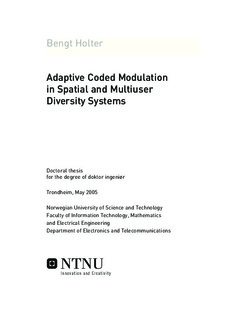Adaptive coded modulation in spatial and multiuser diversity systems
Doctoral thesis
Permanent lenke
http://hdl.handle.net/11250/2368797Utgivelsesdato
2005Metadata
Vis full innførselSamlinger
Sammendrag
This thesis consists of five included papers plus an introduction. The majority of the papers are devoted to performance analysis of an adaptive coded modulation (ACM) scheme based on multidimensional trellis codes. Primarily, single-user systems exploiting spatial diversity are analysed, but results are also presented for a multiuser system exploiting multiuser diversity.
The performance of the ACMscheme is evaluated for slowly flat-fading channels. When spatial diversity is exploited at the receiver end only, the analysis is focused on two different combining techniques: maximum ratio combining (MRC) and switched combining. Amultiple-inputmultiple-output (MIMO) diversity system is also considered, in which case the combined effect of both transmit and receive diversity is realized by using space-time block coding at the transmitter.
For wireless systems using spatial diversity, it is of interest to employ measures which can capture and quantify the performance improvement related to a reduced fading level. In this thesis, ameasure called the amount of fading (AF) is used to characterize the behavior of the error rate curve at a high signal-to-noise ratio (SNR). In particular, closed-form expressions for the AF at the output of a MIMO diversity system are provided, and it is shown that for a constant correlation model, the average symbol error probability at high SNRs may be expressed in terms of the AF.
Finally, a set of switched multiuser access schemes are proposed based on switched diversity algorithms originally devised to select between antennas in a spatial diversity system. ACM is used on each selected link to ensure a high spectral efficiency of the system.
Består av
Holter, Bengt; Øien, Geir E.. Performance Analysis of a Rate-Adaptive Dual-Branch Switched Diversity System. Vehicular Technology Conference, 2006. VTC-2006 Fall. 2006 IEEE 64th: 1-5, 2006.Holter, Bengt; Øien, Geir E.. Impact of Spatial Correlation on Adaptive Coded Modulation Performance in Rayleigh Fading. IEEE Transactions on Vehicular Technology,. 56(3): 1176-1186, 2007.
Holter, Bengt; Øien, Geir E.; Hole, Kjell A.; Holm, Henrik. Limitations in spectral efficiency of a rate-adaptive MIMO system utilizing pilot-aided channel prediction. Vehicular Technology Conference, 2003. VTC 2003-Spring. The 57th IEEE Semiannual. 1(22-25 April): 282-286, 2003.
Holter, Bengt; Øien, Geir E.. On the amount of fading in MIMO diversity systems. IEEE Transactions on Wireless Communications. 4(5): 2498-2507, 2005.
Holter, Bengt; Alouini, Mohammed-Slim; Øien, Geir E.; Yang, Hong-Chuan. Multiuser switched diversity transmission. Vehicular Technology Conference, 2004. VTC2004-Fall. 2004 IEEE 60th. 3(26-29 Sept): 2038-2043, 2004.
